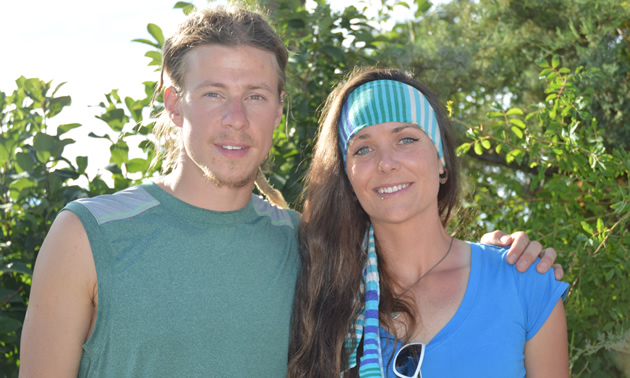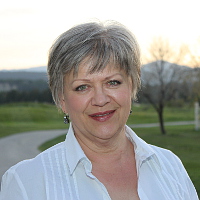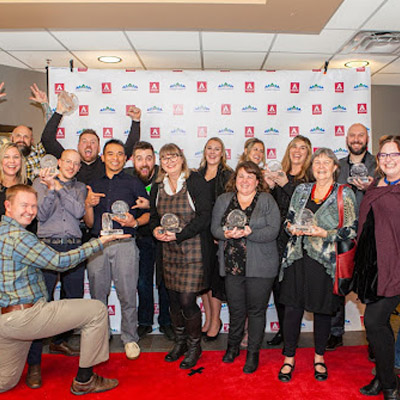Racing for the dream
The Amazing Race Canada provided a very public arena for achievement of this couple's personal goals

Darren Trapp and Kristen Idiens of Fairmont Hot Springs, B.C., competed in the Amazing Race Canada. — Marie Milner photo
Anyone who has been watching the first season of CTV’s Amazing Race Canada is likely familiar with Kristen Idiens (Eye’-deens) and Darren Trapp, the attractive young couple from Fairmont Hot Springs, B.C., who hope to build a sustainable, off-the-grid community.
The dream brought them together
The two met through mutual friends at Fairmont Hot Springs in 2011. At the time, Idiens was on a summer break from her teaching contract in Mongolia and Trapp was employed as an adventure tourism guide at Fairmont Hot Springs. Their shared wish to live sustainably and off the grid was, according to Trapp, the spark that kindled their relationship.
When the couple heard about auditions for the first Amazing Race Canada—with a grand prize that included $250,000, two Chevrolet Stingrays and 10 free trips on Air Canada for one year—they saw it as an opportunity to acquire seed money to found a community based on permaculture and to give their dream some exposure to potential partner-investors. They auditioned and were accepted into the competition.
The Amazing Race itself is over, but only a select few know who the winners are; until the final episode airs in mid-September, that fact will be kept secret.
“The Amazing Race provided us with the motivation to push forward a little more quickly, and a platform for us to make people aware of what we’re doing,” said Idiens.
A vision of community
Idiens and Trapp envision their community as a co-operative, requiring that the inhabitants be invested financially and support its success. The two agree that the best sustainable housing model they have found is a structure called an Earthship, originally designed by architect Michael Reynolds.
“Earthships operate as an entire system, kind of like the human body,” said Trapp. “They have solar panels to gather energy from the sun, and the roof is a water-catchment system for household use and gardening. Most of the outer walls are built out of repurposed car tires and pounded earth—you can get both for free—and they act as a thermal mass to absorb heat.”
The community won’t be an enclave for the environmental dilettante and the eccentric. And far from requiring its inhabitants to live a primitive lifestyle remote from civilization, the Earthship model is suited to people who want a lifestyle of convenience, comfort and social involvement hand in hand with environmental responsibility.
“We will base the community in permaculture,” said Trapp, “with everything working together as a whole, from food production to waste management to power—a complete, efficient system. We hope to produce our own beer and wine, eventually, and have it available in an on-site restaurant or two.”
“This community is open to everybody,” said Idiens, “and it’s meant to be a progressive, long-term lifestyle. Many people think that growing your own food and doing some hard physical work is a move backwards, but there’s great satisfaction in doing that as part of a healthy lifestyle. We will be moving forward in time like the rest of society, using the best skills and technology available.”
Focusing on the practical
Central to the dream is financial stability. Idiens and Trapp are investigating a number of ideas for businesses that would fit well with the philosophy of sustainability and be good income generators, attracting visitors and potential new residents. A spa/wellness/retreat centre is one possibility.
Trapp and Idiens are working on developing a solid business plan, knowing that in order to succeed they need to spend time doing research, finding the right property and the right partners. They are aware that there will be bumps in the road, and are acquiring mentors who can help them have solutions in place when difficult situations arise.
Idiens said that transparency is important, so that anyone who is interested in sustainable community living will understand the standards and expectations before deciding if they want to commit to this lifestyle.
Blended lifestyles
“We’d like to see an overlap of the traditional community with our own,” Idiens said. “We don’t want to do this in isolation. We want a community of people who bring all kinds of skills and talents to the table. This is for people who want to live well and make healthy choices and be part of a productive, sustainable community.”
“The lifestyle won’t be conventional,” Trapp said, “but I think we will be able to find a nice, solid balance.”
“We all have to accept that there will be low points and high points,” Idiens said, “and not get deflected from accomplishing the goal we’ve set. It’s only our own mindset that can prevent us from achieving that, and we are determined.”






Comments